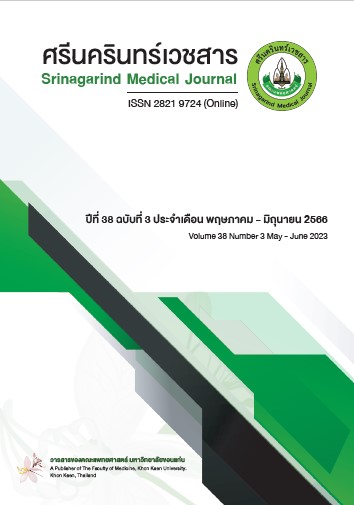Effectiveness of Red Yeast Rice Extract for Blood Lipid Lowering Effect in Hyperlipidemic Individuals
Keywords:
red yeast rice extract, hyperlipidemia, cholesterol, low-density lipoprotein (LDL) cholesterol, triglyceridesAbstract
Background and Objective: Dyslipidemia is a risk factor for ischemic heart disease, the leading cause of death. Red yeast rice consists of substances that decrease blood lipid levels. The purpose of this study was to investigate the effectiveness of consuming red yeast rice extract in decreasing low-density lipoprotein (LDL) cholesterol and cholesterol.
Method: The experimental study was performed at the Medical Correctional Hospital. The population included 20 medical staffs, aged 35-60 years, and was randomly divided into two groups of 10 people each. The experimental group received red yeast rice extract (500 mg/day), while the control group received a placebo. The study period was 8 weeks, and data was analyzed using a student t-test and repeat analysis of variance (ANOVA) tests.
Result: The average cholesterol level in the experimental group at 8 weeks after starting the project decreased by 30.80±6.10 mg/dl, which was statistically significant (p=0.038), while the levels of low-density lipoprotein (LDL) cholesterol, high-density lipoprotein (HDL) cholesterol, and triglycerides were not different. However, triglyceride levels increased on average 44.30±3.18 mg/dl in the control group at 8 weeks after starting the project, which was statistically significant (p=0.044). Other laboratory results were not different at before and after the experiment began.
Conclusion: Red yeast rice extract could reduce blood cholesterol levels.
References
Thai Atherosclerosis Society. 2016 RCPT clinical practice guideline on pharmacologic therapy of dyslipidemia for atherosclerotic cardiovascular disease prevention. Pathum Thani: Thai Atherosclerosis Society; 2017.
World Health Organization. The top 10 causes of death [Internet]. 2018 [Cited 1 Nov, 2022]. Available from: https://www.who.int/news-room/fact-sheets/detail/the-top-10-causes-of-death
National Health Examination Survey Office. Thai nation health examination survey, NHES IV. Nonthaburi: The graphic systems; 2016.
Ward NC, Watts GF, Eckel RH. Statin toxicity. Circ Res 2019;124(2):328-50. doi.org/ 10.1161/CIRCRESAHA.118.312782.
Heber D, Yip I, Ashley JM, Elashoff DA, Elashoff RM, Go VL. Cholesterol-lowering effects of a proprietary Chinese red-yeast-rice dietary supplement. Am J Clin Nutr 1999;69(2):231-6. doi.org/ 10.1093/ajcn/69.2.231.
Cicero AFG, Fogacci F, Banach M. Red yeast rice for hypercholesterolemia. Methodist Debakey Cardiovasc J 2019;15(3):192-9. doi.org/10.14797/mdcj-15-3-192.
Yang CW, Mousa SA. The effect of red yeast rice (Monascus purpureus) in dyslipidemia and other disorders. Complement Ther Med 2012;20(6):466-74. doi.org/10.1016/j.ctim.2012.07.004.
Ding M, Si D, Zhang W, Feng Z, He M, Yang P. Red yeast rice repairs kidney damage and reduces inflammatory transcription factors in rat models of hyperlipidemia. Exp Ther Med 2014;8(6):1737-44. doi.org/10.3892/etm.2014.2035.
Lin CC, Li TC, Lai MM. Efficacy and safety of Monascus purpureus Went rice in subjects with hyperlipidemia. Eur J Endocrinol 2005;153(5):679-86. doi.org/10.1530/eje.1.02012.
Huang CF, Li TC, Lin CC, Liu CS, Shih HC, Lai MM. Efficacy of Monascus purpureus Went rice on lowering lipid ratios in hypercholesterolemic patients. Eur J Cardiovasc Prev Rehabil 2007;14(3):438-40. doi.org/10.1097/HJR.0b013e32801da137.
Burke FM. Red yeast rice for the treatment of dyslipidemia. Curr Atheroscler Rep 2015;17(4):495. doi.org/10.1007/s11883-015-0495-8.
Becker DJ, Gordon RY, Halbert SC, French B, Morris PB, Rader DJ. Red yeast rice for dyslipidemia in statin-intolerant patients: a randomized trial. Ann Intern Med 2009;150(12):830-9, W147-9. doi.org/ 10.7326/0003-4819-150-12-200906160-00006.
Halbert SC, French B, Gordon RY, Farrar JT, Schmitz K, Morris PB, Thompson PD, Rader DJ, Becker DJ. Tolerability of red yeast rice (2,400 mg twice daily) versus pravastatin (20 mg twice daily) in patients with previous statin intolerance. Am J Cardiol 2010;105(2):198-204. doi.org/ 10.1016/j.amjcard.2009.08.672.
Heinz T, Schuchardt JP, Möller K, Hadji P, Hahn A. Low daily dose of 3 mg monacolin K from RYR reduces the concentration of LDL-C in a randomized, placebo-controlled intervention. Nutr Res 2016;36(10):1162-70. doi.org/10.1016/j.nutres.2016.07.005.
Bruno A, Pandolfo G, Crucitti M, Troili GM, Spina E, Zoccali RA, Muscatello MRA. Red yeast rice (RYR) supplementation in patients treated with second-generation antipsychotics. Complement Ther Med 2018;37:167-71. doi.org/10.1016/j.ctim.2018.03.007.
Cicero AF, Derosa G, Parini A, Maffioli P, D'Addato S, Reggi A, Giovannini M, Borghi C. Red yeast rice improves lipid pattern, high-sensitivity C-reactive protein, and vascular remodeling parameters in moderately hypercholesterolemic Italian subjects. Nutr Res 2013;33(8):622-8. doi.org/10.1016/j.nutres.2013.05.015.
Chen F, Hu X. Study on red fermented rice with high concentration of monacolin K and low concentration of citrinin. Int J Food Microbiol 2005;103(3):331-7. doi.org/10.1016/j.ijfoodmicro.2005.03.002.
Cicero AFG, Fogacci F, Zambon A. Red yeast rice for hypercholesterolemia: JACC Focus Seminar. J Am Coll Cardiol 2021;77(5):620-8. doi.org/10.1016/j.jacc.2020.11.056.
Schachter M. Chemical, pharmacokinetic and pharmacodynamic properties of statins: an update. Fundam Clin Pharmacol 2005;19(1):117-25. doi.org/10.1111/j.1472-8206.2004.00299.x.
Cox RA, García-Palmieri MR. Cholesterol, triglycerides, and associated lipoproteins. clinical methods: the history, physical, and laboratory examinations. 3rd ed. Boston: Butterworths; 1990
Downloads
Published
How to Cite
Issue
Section
License
Copyright (c) 2023 Srinagarind Medical Journal

This work is licensed under a Creative Commons Attribution-NonCommercial-NoDerivatives 4.0 International License.




